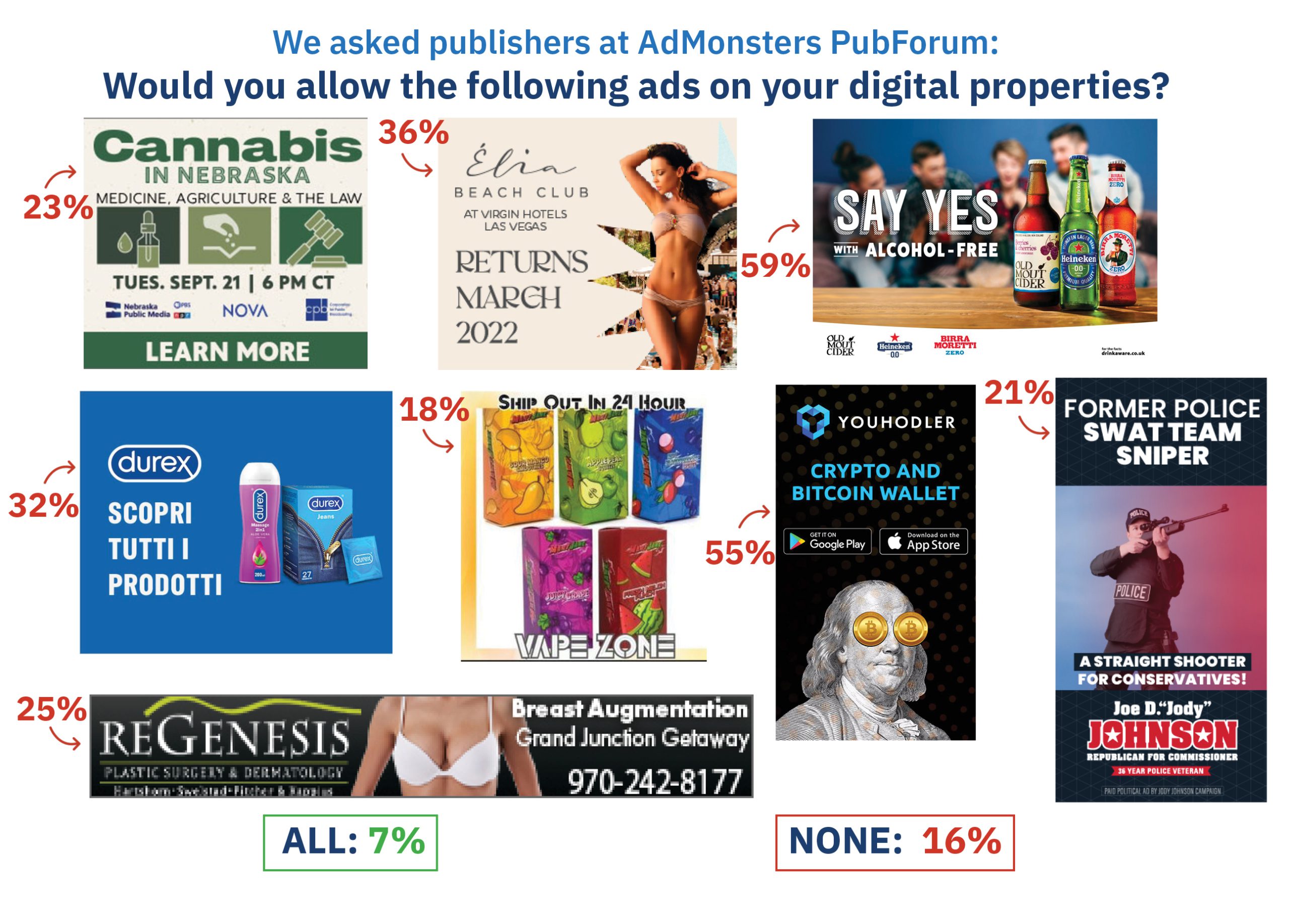
AdMonsters PubForum attendees weigh in on acceptable creative and how to build a creative review process
“I know it when I see it,” U.S. Supreme Court Justice Potter Stewart famously commented about obscenity in a 1964 ruling. Most digital publishers likely have the same view about “bad ads,” but identifying what’s acceptable to run on your properties is often… harder than it looks.
Sure, no publisher wants malware emerging from the ad pipes onto their audiences’ devices or heavy ads decimating user experience, but what about sensitive and regulated ad content? There’s low-hanging fruit like nudity, but what about cannabis? Crypto? Tobacco, alcohol, political, medical, pharmaceutical—the list of sensitive and regulated content goes on and on. And you know you can’t rely on pre-declared categories based on the IAB Content Taxonomy to keep you in the clear.
We gave the publisher attendees at AdMonsters March 2022 Publisher Forum a pop quiz. We put together a postcard with eight ads (see above) in a variety of sensitive categories identified via The Media Trust’s proprietary AI-human-hybrid Ad Categorization system, and then asked publishers to choose which ads they would allow on their digital properties.
Only 7% of responding publishers said they would accept all of the ads on the postcard, while 16% percent said “No thanks” to all.
But we weren’t going to make these decisions easy: we specifically looked for ads in a “gray zone”—for example, a cannabis-related ad not hawking marijuana products and paraphernalia, but promoting a business conference sponsored by public broadcasting services. Some of these even fit into multiple sensitive categories: an ad with a local political candidate brandishing a sniper rifle gets labeled both “Political” and “Weapons.”
The variety of responses was eye-opening, but certainly not surprising—tolerance thresholds for certain sensitive ad content differ widely among publications. Only 7% of responding publishers said they would accept all of the ads on the postcard, while 16% percent said “No thanks” to all. A few only approved the crypto ad, while several pubs were just OK with the alcohol-free beer ad alone.
The percentage of publishers that would allow ads for:
- Cannabis conference sponsored by NPR and NOVA: 23% ✅
- Hotel featuring a woman in a revealing bikini: 36% ✅
- Non-alcoholic beers: 59% ✅
- Condoms and sexual lubricant: 32% ✅
- Fruity cartridges for tobacco vapes: 18% ✅
- Crypto/bitcoin wallet app: 55% ✅
- Political candidate holding sniper rifle: 21% ✅
- Breast augmentation services featuring a closeup of a bosom in a bra: 25% ✅
Policy Backup for Tough Decisions
This exercise was meant to stress the importance of building robust but flexible acceptable ad policies that protect consumers and the publisher brand. No two publisher policies will look alike because each organization will have vastly different needs. And then you’ll need to iterate constantly with societal trends. Cryptocurrency is a great example: a few years ago, few premium publishers would touch this category, but after a Super Bowl chock full of celebrities promoting crypto exchanges, 55% of those surveyed would accept an ad for an app named YouHodler.
Deciding what ad content is acceptable or not on your properties requires policy backup. Even then, you need tools that can execute on nuance, to better judge what kind of ads might appear in a sensitive content category, you should be able to set your real-time ad quality solution (e.g., Media Filter) to notify. And a creative gallery like our Ad Sentry feature can help you block specific ads and campaigns that violate your standards.
After a Super Bowl chock full of celebrities promoting crypto exchanges, 55% of publishers surveyed would accept an ad for an app named YouHodler.
As detailed in our presentation at PubForum, there’s a straightforward, five-step process for building (or bolstering) a creative review process.
- Establish: Grab key stakeholders from other departments (e.g., editorial and product) and set your baselines when it comes to ad formats, ad specifications, and ad content.
- Prioritize: Determine your current status versus where you want to be, then drill down to the most crucial policies and weigh the importance of each (especially against each other—e.g., a porn ad is worse than a heavy ad).
- Measure: Figure out how many policy-violating ads are appearing on your site daily/weekly/monthly and from where.
- Enforce: Find tools that can execute your policies on the site/app level while also informing demand partners and establishing consequences for failing to comply.
- Iterate: Repeat this process on all sites and apps you manage; revisit policies on a regular basis (e.g., quarterly) using hard data from your ad quality provider; and revise when policies aren’t working as intended or social circumstances evolve (think cryptocurrency or cannabis).
If you want some help in fleshing out your creative review process, just ask. Our team has been helping publishers and AdTech firms optimize their creative policies for years. After all, we want to see consumers safe while publisher brand safety remains intact.
Bad Ad Nostalgia
Finally, we asked publisher attendees to share stories of specific ads that caused them a lot of misery. Maybe an executive screamed at them about offensive creative, maybe it was an unstoppable redirect, or maybe it was a direct campaign with horrifically defective rich media. Ad ops people love sharing these stories because everyone in the field can relate.
Here are some anecdotes publishers shared—see if they sound familiar.
- Ad from a major retailer featuring a woman in a bikini not covering much
- Very graphic ad for ear wax cleaner
- An overlay ad that refused to close and sucked up half a day of vacation time for the ad ops leader
- A Russian dating app following an executive around the site—the ad ops team couldn’t identify the URL to block
- An ad featuring a well-endowed woman in a bikini and boxing gloves punching her chest (“Bizarre”)
- Hilary Clinton with devil horns and a lizard tongue
We quite enjoy these tales too and keep a little collection. Feel free to share your story about an ad that totally messed up your day!



